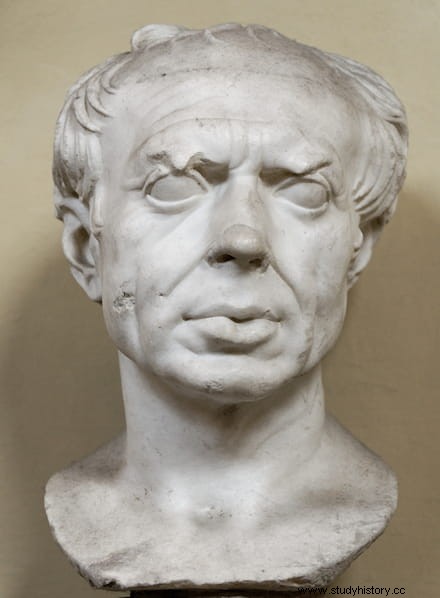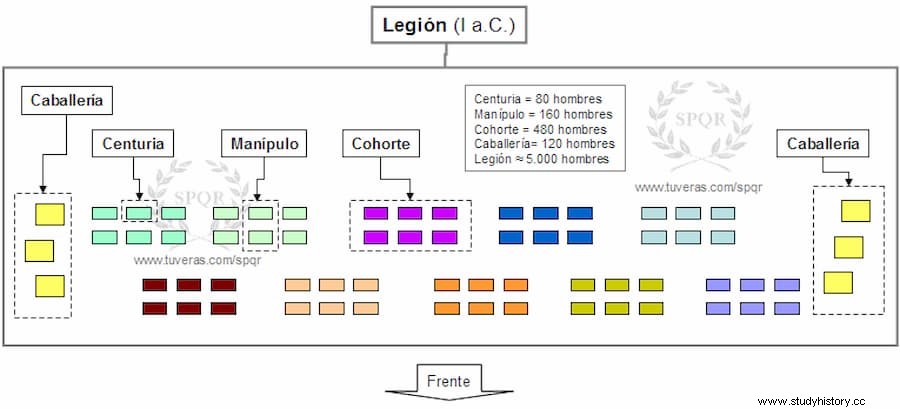On horseback between the 2nd century B.C. and I BC, the Roman army underwent a profound transformation that turned it into the fabulous war machine that dominated the Mediterranean world and laid the foundations of an empire that lasted more than half a millennium. Ironically, this came about from the collapse suffered by the Republic when the generals used that formidable force to achieve their ambitions, something that was not in the mind of Gaius Mario, the author of those transcendental military reforms.
If at the end of the second century B.C. Rome seemed to be in full swing, dominating the Mediterranean after its victories in the Punic Wars, the conquest of much of Hispania and the annulment of the danger posed by the Seleucid Empire, the truth is that internally the situation was not so bright. With the power of the Senate limited in the proconsular provinces and a polarized society between an aristocratic elite, which increased its wealth while occupying the leadership positions, and another popular elite increasingly impoverished due to the massive increase in slaves, which sank wages , any unexpected alteration threatened to bring down that house of cards.

The abundant slave labor, moreover, brought another problem apart from the economic one:that inherent in the fact that the free population was much smaller in number, which constituted an obvious security risk. It was demonstrated by the Eunoo revolt in Sicily, which could only be put down at the cost of a significant recruitment... which left the fields abandoned and their owners in debt, being forced to migrate to the cities. This meant that they lacked the means to pay for their military equipment, thus losing their right to join the army and, with it, any possibility of social promotion.
The issue was troubling enough that some attempts at reform were made. The Sempronio Graco brothers, Tiberius and Gaius, picked up an earlier idea from Gaius Lelio to limit the amount of land that each citizen could own and distribute the surplus among the less favored in exchange for the payment of a tribute and the commitment not to sell them; They also tried to reduce military service to those over sixteen years of age and introduce the novelty that it was the state that provided the soldier's equipment.
The Gracchi ended badly and their laws were abolished, confirming the division of Roman power between optimates (aristocrats) and popular (who were also popular but based their strength on the assemblies of the people). The latter coined the figure of the new man , the one capable of breaking the monopolization of the magistracies by the same families (something that continued in practice despite the fact that two centuries earlier the political marginalization of commoners had been eliminated, since they were incorporated into a new mixed aristocracy that was equally exclusive ), and the figure of Cayo Mario emerged.
Born around the year 157 BC, he belonged to a wealthy family of plebeian origin and originally from Arpino, a city in Lazio whose inhabitants did not obtain Roman citizenship until 188 BC. We are not going to tell in detail the life of this character, but we do point out that the Marios had already risen to the equestrian class and Gaius joined the ranks, acquiring war experience under the command of Scipio Emiliano, who was the one who encouraged him to start a political career. And indeed, his cursus honorum he grew fat little by little:tribune of the plebs, senator, praetor and, after his triumph in the war against the Numidians of Jugurtha, acceded to the first of his consulships; then another six would come.

It was during the first and second when he undertook the military reforms that are usually known by his name and that shaped what would be the basic model of the Roman army during the rest of the Republic and the first centuries of the Empire. It was necessary to adapt to the new reality of a Rome that had become a hegemonic power, with distant borders that required troops fully dedicated to its custody and that did not depend on loot, which was increasingly reduced because there were no longer enemies on the heights. Something that had caused absenteeism before the recruitments at the same time that it prevented the consolidation of a group spirit among the legionnaires, since, in addition, the armies were dissolved at the end of the campaign.
On the other hand, the number of mobilized soldiers was around fifty thousand, which meant between fifteen and twenty percent of the adsidui , that is, the taxpayers, the male population who were required to be part of the census, have property valued at least three thousand sesterces and be able to pay their panoply in order to join the army. These socio-economic conditions were reflected in the military establishment in a series of bodies according to them.
At the top were the equites, the cavalry, made up of members of the ordo equester that they could cost a horse and, therefore, their number was limited, numbering little more than four thousand men. The infantry was subdivided into: velites (the light legionnaires, with fewer resources, lacking weapons and protection, who used to start battles in the front line by throwing javelins and stones and then take cover in the rear); hastati (lower-middle class youth who fought in the front line with basic armor, a small shield, a sword and two stacks ); princes (socioeconomically above the previous ones, which allowed them to be more protected, although the weapons were the same; they fought in the second row); triarii (veterans who formed the rearguard, forming a phalanx and entering the fray only in extreme cases).
Demoralization and lack of troops were two serious immediate problems that Mario encountered when assuming the first consulate; he simply did not find enough men, so he resorted to Italian allies and foreign mercenaries, before levying among the advocati . But all this turned out to be slow and insufficient, so he did something unusual:replace the dilectus (classic recruitment) enlisting capite censi (the poorest commoners), arming them at the expense of the state and offering them the possibility of earning a salary that would increase with the spoils. He thus solved two birds with one stone:the shortage of soldiers and the way of life for a class without means, since they were contracted for a period of sixteen years, extendable to twenty.
With these forces he victoriously ended the Numidian war that his previous superior, Quintus Cecilio Metelo, had left unfinished. Then, an emigration to the south of barbarian peoples (mainly Cimbri and Teutons but also others that were joining them), pushed by a climate change that flooded the land of his origin, led him to be re-elected consul. The situation was alarming because two Roman armies had been defeated and Mario found himself in the position of reassuring the population while recruiting new troops, to which he joined the more experienced of the other consul, Publius Rutilio Rufo.
The threat was saved without further fighting when the barbarians temporarily withdrew. This allowed Mario to focus his efforts on carrying out a second military reform that totally transformed the legions. The most notable effects were the culmination of professionalization, with the army becoming more or less permanent, and homogenization, with the suppression of the social class structure. Hastati , princes and triarii they disappeared to make way for a unique type of heavy legionnaire, with full panoply and weaponry. Ineffective velites were also removed , replaced by auxiliary troops from the provinces.
Not having to return to tend their fields and thus being cut off from production, relying only on pay and loot, soldiers could stay in military service much longer and use it to improve their training. Interestingly, Mario preferred those of agrarian descent, considering them tougher and more long-suffering. And suffer, they suffered, since they made long marches at twice the speed than before (about five kilometers per hour on average) carrying all the impedimenta, since the baggage carts were also eliminated.
The armament was the same for all:helmet (model coolus , coexisting with the montefortino), chain mail, shield, sword (gladius Hispaniensis ), pugio (dagger), pilum light and pilum heavy, no greaves. To this were added sapper tools (shovel and pickaxe, since a good part of the training was dedicated to the construction of roads and camps), the caligae (sandals), the balteus (belt), the sagum (wool cape), a saucepan, a cup, a sickle (which was used not only to mow but also to repel cavalry, if placed on the end of a ribbon), a canteen, cereal rations, cutlery, a mat (for sleeping), etc. In total, a weight between thirty and forty kilos that was carried in a leather bag hanging from a wooden furca (a long pole with a crossbar; according to some authors, the pilum itself ).
These changes implied others in the organization of the legion and its tactics, keeping only the arrangement in three lines, the triplex acies , although now they all had the same level of equipment and skill. The maniple, which to date was made up of two centuries of sixty men each (except those of triarii , which numbered thirty), ceased to be the basic unit in favor of the cohort, which had three maniples of two hundred men each. Generally, four cohorts were placed in the first row, three in the second and third; at the maniple, the second century formed behind the first.

The legion came to be made up of six thousand legionnaires divided into six or ten cohorts of six centuries, each of which had eighty troops. In turn, the centuries were subdivided into groups of eight individuals, who were assigned a mule to transport the tent, a stone mill, sacks of provisions, wooden stakes and other useful objects. In command of each century was a centurion assisted by an optio , reporting to a senior centurion in each legion, the primus pilus . The military tribunes led two cohorts each under the orders of a legate.
The cohort structure provided the Romans with greater maneuverability and the security of having troops at all times who, on top of that, were professionals and did not need to be hastily trained. Cunningly, Mario encouraged that pride by being sparing in punishments (he preferred to appeal to the virtus , a traditional Roman concept that included morality and courage) and introducing a common symbol for all, above the multitude of banners existing until then, that provided group feeling:the eagle.
The legionnaires themselves were fully satisfied because at the end of their service they received a farm in the conquered territories, ensuring a means of subsistence and collaborating in the process in the romanization of the territory; if they were Italic they could even get Roman citizenship as a reward. Of course, a problem arose that Mary Beard synthetically explains:
